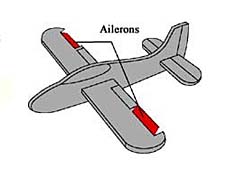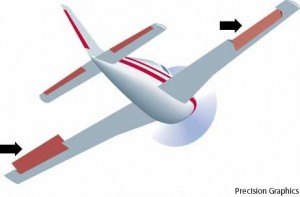Smart Flight Training’s goal is to take the mystery out of aviation for those who want to learn to fly by discussing flight training terms and showing pictures and video where we can.
We hope that reading about, seeing, and watching aviation in action will help you learn to fly more efficiently – saving you money at your flight school and during all of your flight training!
This Wednesday, we will take a look at one of the “control surfaces” of you flight training aircraft, the aileron.

An aileron (French for “little wing”) is a movable flap on the wing of an airplane used to control the plane’s side-to-side movements. Ailerons cause one wing tip to move up and the other wing tip to move down, helping a plane turn. To bank to the left, a pilot must raise the left aileron and lower the right aileron. Ailerons are located on the back of the wing (known as the “trailing edge”) and near the wing tips.

All ailerons work the same way, whether you are a student learning to fly a light sport aircraft or an airline pilot flying a Boeing 747.
As you continue to learn to fly, you’ll find out more than you ever thought you would want to know about ailerons, including their effect on the yaw of an aircraft in addition to the roll, and what you can do if you lose the ability to control the ailerons in flight.
But all of that is for a future flight training post! Until then, enjoy this YouTube video of ailerons at work… Notice that the ailerons do not have to move very much to do their job!
Learn to fly faster and smarter with Smart Flight Training: join our mailing list and get involved in the community by leaving a comment below!